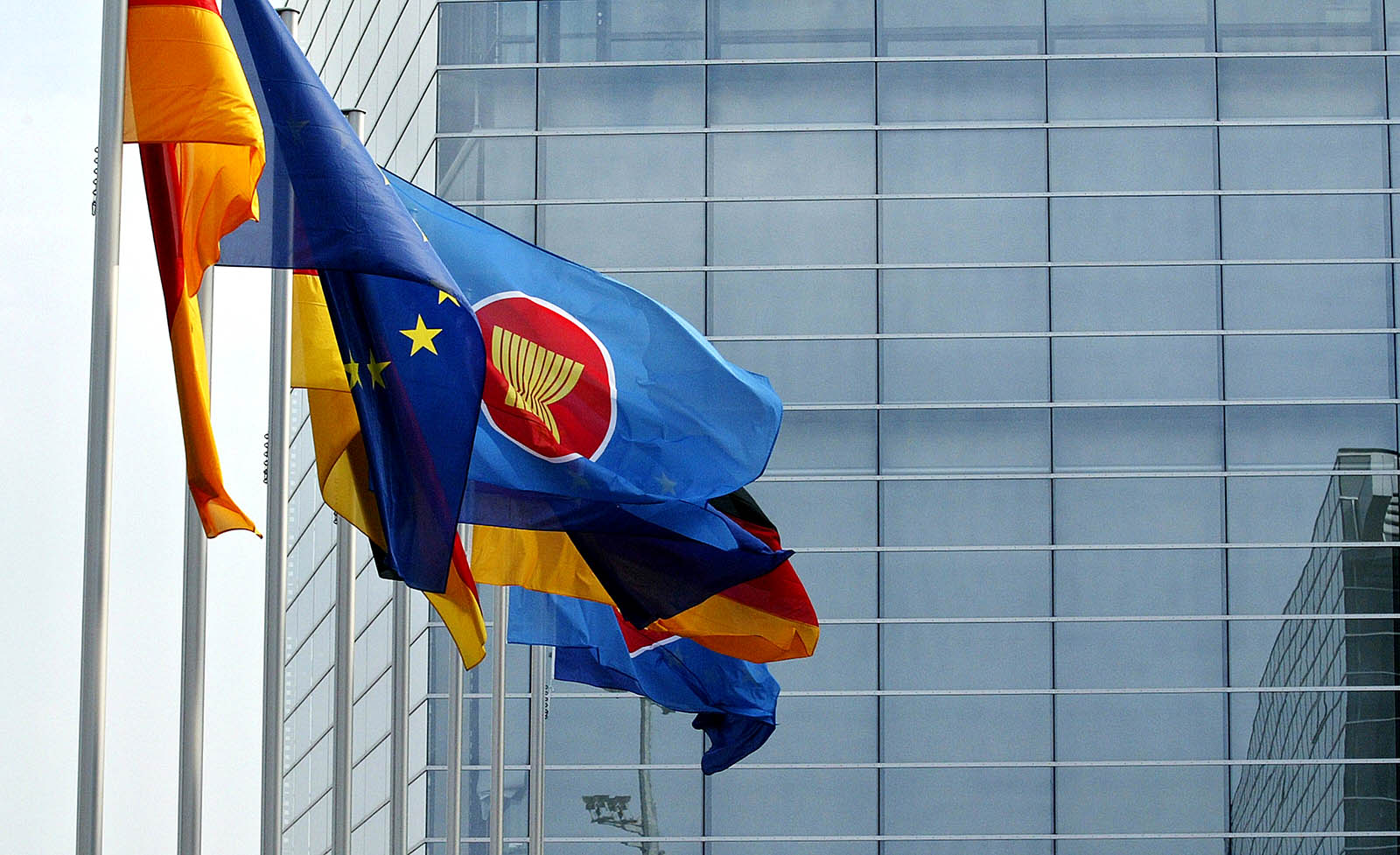Is the ASEAN Model Superior to the EU?

Flags of EU and ASEAN wave in Nuremberg, Germany. Recent events call into question whether the EU's deep integration is the better model.
Photo: Jean-Christophe Verhaegen/AFP/Getty Images
Since the Asian financial crisis of 1997, when Thailand failed to count on the support of ASEAN in its defense against speculative attacks on its currency, mainstream thinking is that implementing a substantial number of common policies across regions and beyond trade measures can help to weather storms against individual members. This is called “deep integration,” for which the EU–with the EU Commission as a guardian of common policies–is the textbook example.
In contrast, ASEAN is the textbook example of shallow integration, with no common policies administered or supervised by the ASEAN Secretariat. When ASEAN was founded in 1967, the former European Economic Community had already implemented its first step toward deep integration by agreeing on a common external tariff for most industrial products.
Shallow or Deep Integration: Which Is the Better Model?
The distinction between deep and shallow integration was coined by Harvard economist Robert Lawrence in 1996 in a monograph on regionalism and multilateralism. With deep integration, the distance between domestic policies and common policies shrinks and the former gets subordinated to the latter.
However, the assumption that deep integration protects the members of a grouping against the headwind of global crises better than shallow integration requires qualification, perhaps even a revision. Among a number of challenges fostering disintegration (including Brexit as a special case), the EU became exposed to financial stress between liquid Northern European countries and illiquid or even insolvent Southern European countries after the financial crisis of 2008. They were also exposed to political stress between Eastern and Western Europe when dealing with the inflows of refugees in 2015. In contrast, ASEAN has never produced such headlines about threats to further integration.
Yet, the achieved status of intra-ASEAN mobility of capital, goods and services (but not labor) has never been put at risk, unlike in the EU where internal borders against the movement of people were set up again by suspending the Schengen agreement, allowing people to cross borders without control. Of course, falling back from a high level of deep integration differs from losing the modest achievements of shallow integration, but it cannot be guaranteed that the former is always less costly than the latter. To put it differently, a roller-coaster path of deep integration first–followed by escalating disintegration later–can be more costly than a steady path of integration that remains shallow.
The Costs of Deep Integration
This hypothesis invites two questions. First, have there been processes in the EU through which disintegrating forces became stronger than those leading to more integration? Second, what costs emerge when EU’s deep integration derails and instead the roller-caster path starts, and why can these costs be higher than those opportunity costs incurred by not deepening integration in ASEAN?
As to the first question, in retrospect, there have been three such processes in the EU. First, the parallel course of integrating—deepening by more common policies and widening by accepting new members—sharpened per capita income disparities between old and new members. To meet the requirements of common policies, the poorer members asked for more fiscal transfers from the richer members, which these members so far have rejected. Without such transfers, the poorer members have argued, the high standards of common policies could not be fulfilled from their weak domestic tax base. That implies that either the entry of new members or the further deepening of integration should have been stopped. Instead, by continuing both deepening and widening, rising economic and social disparities provoked the feeling in poorer members that richer members gained income at their expense.
The EU’s ‘deep integration’ is assumed superior, but ASEAN’s ‘shallow integration’ is withstanding the test of time.
Second, the monetary union seems to have weakened the competitiveness of the poorer countries relative to the richer countries. Falling risk premiums on public debt issued in euros by the poorer members were consumed in the poorer countries, thus driving wages there lower relative to those in the richer countries. In hindsight, the monetary union did not become a vehicle of further real-sector integration–as was hoped–but a barrier, because it denied the poorer countries the option of nominal exchange rate depreciation in times of stress. Without this option, they had to reduce nominal wages under the common currency to defend their competitiveness against the richer members. This fueled anger about the “iron fist” of austerity claims of the richer countries and destroyed the positive momentum of integration as a benefit for all members.
Finally, free mobility of labor has become the third source of trouble. From the very beginning of the EU integration process, free mobility of labor was always politically much more controversial than free mobility of capital. Xenophobia and fears against low-wage competition have ranked high in the mindsets of many EU citizens, even against people from other EU members. It could be suppressed when trade and capital movements substituted for intra-EU labor flows, but with the slowing down of growth in trade and capital flows, people had to move where the jobs were. This has met resistance in the UK, where it became the strongest tailwind for Brexit. All three processes have so far been avoided by ASEAN. There are no common policies, no monetary union and no free mobility of labor.
As to the second question, the economic costs from disintegration in the EU are high because of the lack of efficient alternatives to legally backed deep integration. The economic strength of the EU rests upon the stability of dense cross-border supply chains, a benign neglect of state insolvency risks and upon the guarantee of the legal framework of integration achievements since 1957. When these three pillars are hollowed out by barriers to labor movements, by pricing in higher risks of state insolvency into the cost of borrowing, and by blatant refusal of several EU members to accept and implement EU law and regulations, the EU economy faces sand in its gears.
Why the ASEAN Way Could be More Fruitful
In brief, ASEAN’s market-driven shallow integration without a strong legal body implements what is politically feasible, while the EU’s legalistic approach to deep integration is highly vulnerable to setbacks caused by unilateral actions of individual members against deep integration. To put it differently, while ASEAN at 50 is still moving along its possibility frontier curve, the EU at 60 seems to have underrated the risks involved in shifting this curve continuously upward.


